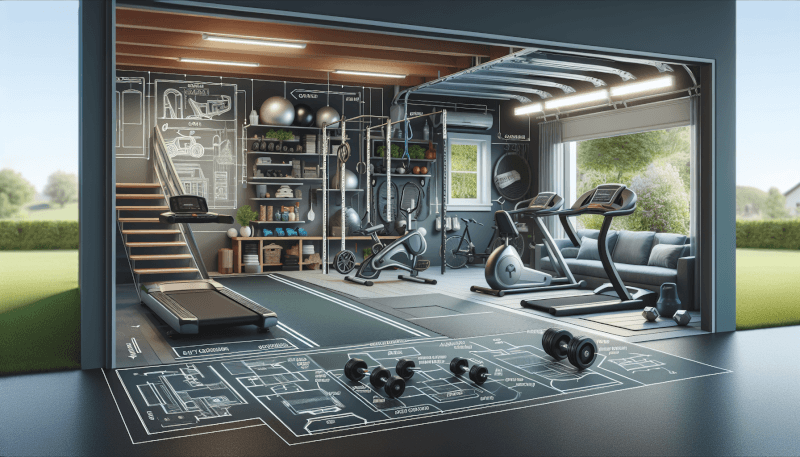Imagine having the convenience of a fully equipped gym just a few steps away from your front door. With the rising popularity of home workouts, creating your own DIY home gym in your garage has never been easier. This article provides you with essential tips and tricks to transform your garage into your personal fitness sanctuary. Say goodbye to expensive gym memberships and hello to a convenient and personalized space where you can prioritize your health and fitness goals. Get ready to discover how simple and rewarding it can be to build your own DIY home gym in your garage.

Choosing the Right Garage Space
When it comes to building a DIY home gym in your garage, the first step is to assess the available space. Garage sizes can vary, so it’s important to determine how much room you have to work with. Take measurements of the length, width, and height of the garage to get a clear idea of the space you can allocate for your gym equipment.
In addition to measuring the physical dimensions of the garage, you should also consider the layout and any obstacles that may limit the use of certain areas. Are there any support beams, windows, or doors that could affect the placement of your equipment? By taking these factors into account, you can ensure optimal use of the available space and create a gym layout that suits your needs.
Another important aspect to consider when choosing the right garage space for your DIY home gym is ventilation and lighting. Proper ventilation is crucial to ensure good air circulation and keep the space comfortable while you work out. Look for options to optimize airflow, such as windows, vents, or even installing a fan.
Lighting is also essential for a functional and inviting workout space. Choose lighting features that provide sufficient brightness for your workouts, ensuring that the entire area is well-lit to prevent accidents or injuries. Consider both natural light and artificial lighting options, and design your gym layout accordingly.
Lastly, it’s important to check for any moisture or humidity issues in your garage. Excessive moisture can lead to mold or mildew growth, which can be harmful to your health and damage your equipment. Ensure that your garage is properly sealed, and consider using a dehumidifier if necessary. If you spot any signs of moisture or humidity, address these issues before setting up your DIY home gym.
Setting a Budget
Before diving into the exciting world of DIY home gyms, it’s important to set a budget for your project. Determining your spending limit will help guide your decisions when it comes to purchasing equipment and making any necessary renovations.
Begin by evaluating your overall financial situation and deciding how much you can comfortably afford to allocate towards your DIY home gym. Remember to factor in not just the cost of the equipment, but also any potential renovations, flooring, electrical work, and additional accessories you may need.
Once you have a clear idea of your spending limit, research equipment costs to get a sense of what is available within your budget. Compare prices from different retailers and read customer reviews to ensure you are getting good value for your money. It’s also important to consider the long-term investment and durability of the equipment, as cheaper options may not last as long or provide the same level of quality.
Exploring DIY options can also help you stay within your budget while creating a personalized gym space. From building your own weightlifting rack to creating resistance bands and weights, there are plenty of ways to save money and still achieve a fully functional home gym. Do thorough research, gather necessary materials, and follow reliable DIY guides to ensure your projects are safe and effective.

Designing the Layout
Designing the layout of your DIY home gym is an exciting step in the process, as it allows you to create a space that is aesthetically pleasing and tailored to your workout preferences. Start by considering the type of workouts you plan to do in your home gym. Will you focus on strength training, cardiovascular exercises, or a combination of both? This will help you determine what equipment you will need and how much space to allocate for each activity.
To optimize space utilization, take into account the dimensions of your equipment and create a floor plan that allows for easy movement and accessibility. Consider how much space is needed around each piece of equipment to perform exercises comfortably and avoid any potential hazards. Mapping out equipment placement in advance will ensure a smooth and efficient workout experience.
As you design the layout, take into account any specific needs you may have. If you will be doing yoga or Pilates, allocate space for a mat and consider including a designated area for stretching and warm-up exercises. Customizing the layout based on your preferences and goals will enhance your overall workout experience and make the most of the available space.
Building Necessary Infrastructure
Once you have assessed the space, set a budget, and designed the layout of your DIY home gym, it’s time to prepare the garage for its new role. Start by clearing out any unnecessary items and decluttering the space. This will not only create a clean and organized environment but also allow for easier movement and access to your gym equipment.
Next, inspect the walls and flooring for any damage or imperfections. Repairing any cracks, holes, or uneven surfaces will create a safe and stable foundation for your workouts. Consider applying a fresh coat of paint or installing wall coverings to give your garage a more inviting and motivating feel.
Installing appropriate electrical outlets is another important aspect to consider. Depending on the equipment you plan to use, you may need access to multiple outlets. Consult with an electrician to ensure that your garage’s electrical system can handle the load and safely accommodate your needs. Adding additional outlets or surge protectors will help prevent electrical hazards and make it easier to plug in your equipment.

Choosing Essential Equipment
Now that you have prepared the space for your DIY home gym, it’s time to choose the essential equipment that will help you achieve your fitness goals. Start by determining what your fitness goals are. Are you looking to build strength, improve cardiovascular health, or both?
When selecting equipment, it’s important to choose versatile options that can accommodate a variety of exercises. This will allow for more flexibility in your workouts and make the most of the available space. For example, a set of dumbbells or resistance bands can be used for a wide range of exercises and take up less space than multiple machines.
It’s also crucial to include both cardio and strength training options in your equipment selection. Cardiovascular exercises, such as treadmills, stationary bikes, or rowing machines, are essential for boosting your heart rate and burning calories. Meanwhile, strength training tools like barbells, weight plates, or resistance machines will help you build muscle and increase overall strength.
Consider your budget and space limitations when choosing equipment. It’s better to prioritize quality over quantity, investing in a few key pieces that will serve you well in the long run. Research reputable brands, read customer reviews, and take warranty options into account when making your final decisions.
Exploring DIY Equipment Solutions
If budget constraints or personal preferences lead you to explore DIY options for your DIY home gym, there are several projects you can undertake to create your own equipment. Building a weightlifting rack can be a rewarding project that allows you to customize the dimensions and design to fit your specific needs. Follow reliable DIY guides and use sturdy materials to ensure safety and structural integrity.
Constructing a workout bench is another DIY project that can save you money and add versatility to your gym space. Choose a design that suits your workout preferences and provides stability and comfort. Opt for materials that are durable and able to withstand the demands of various exercises.
Creating resistance bands and weights is a more cost-effective alternative to purchasing them. There are numerous DIY guides available online that provide step-by-step instructions for making your own resistance bands using commonly available materials. Similarly, you can easily create your own weights using items such as sandbags or gallon water jugs filled with water or sand. These DIY solutions are not only budget-friendly but also customizable to your desired resistance levels.

Ensuring Safety Measures
Safety should be a top priority when setting up your DIY home gym. Several measures can be taken to create a safe environment for your workouts. Installing proper flooring and mats is essential to prevent injuries and protect your equipment. Consider materials such as rubber flooring or foam tiles, which provide cushioning and grip, reducing the risk of slips or falls.
Securing equipment with brackets or weights is another safety measure that should not be overlooked. As you perform exercises, equipment may become unstable or tip over, posing a risk of injury. Use brackets to secure heavier equipment to the walls or floor, and ensure that weight plates are properly secured to prevent them from moving during exercises.
Proper lighting and ventilation are also crucial for a safe and comfortable workout experience. Well-lit areas will allow you to see your surroundings clearly and detect any potential hazards. Adequate ventilation will help remove any buildup of heat, moisture, or odors, ensuring a fresh and breathable atmosphere.
Investing in Quality Equipment
Investing in quality equipment is key to creating a DIY home gym that will stand the test of time. Research reputable brands that are known for their durability, reliability, and customer satisfaction. Online reviews and testimonials from other users can provide valuable insights into the performance of different equipment models.
When considering which equipment to invest in, also take warranty options into account. A longer warranty period can offer peace of mind and protect you from unexpected equipment failures. Compare warranty terms and conditions and choose equipment that offers the best coverage for your needs.
While it may be tempting to choose the most affordable option, remember that your DIY home gym is a long-term investment in your health and fitness. Opting for quality equipment, even if it comes at a higher price, will ensure a safer and more enjoyable workout experience. Budget accordingly and prioritize your needs to make the most informed decisions.

Maximizing Space with Storage Solutions
Effective storage solutions are essential for maximizing the space in your DIY home gym and keeping it organized. Installing wall-mounted shelves can help keep small items, such as towels, water bottles, or resistance bands, off the floor and easily accessible. Utilizing pegboards and hooks can provide a flexible and customizable storage solution for larger items like resistance bands, jump ropes, or yoga mats.
If you have limited wall space, consider using storage cabinets or racks to keep your equipment organized and easily accessible. Ensure that the cabinets or racks are sturdy enough to hold the weight of your equipment and allow for easy retrieval when needed.
By maximizing the use of vertical space, you can create a clutter-free environment that maximizes your available workout area. Keep in mind that proper organization not only enhances the visual appeal of your DIY home gym but also promotes safety by reducing tripping hazards and minimizing the risk of injuries caused by equipment lying around.
Setting Up Entertainment and Motivational Elements
No gym is complete without some entertainment and motivational elements to keep you engaged and motivated during workouts. Installing a TV or speakers can provide a source of entertainment, allowing you to watch your favorite shows or listen to music while exercising. Consider mounting the TV on the wall or using a wall-mounted bracket for speakers to save space and prevent damage.
Creating a motivating workout playlist is another way to keep your energy up and stay focused on your fitness goals. Curate a collection of your favorite songs or explore themed playlists that match the intensity of your workouts. Music has a powerful effect on mood and can enhance your overall workout experience.
In addition to entertainment, it’s important to include a comfortable seating area in your DIY home gym. This can be a space where you can sit and rest between sets or simply relax after a strenuous workout. Choose comfortable seating options that fit the overall design of your gym and create a cozy atmosphere.
By incorporating these entertainment and motivational elements into your DIY home gym, you can create an environment that not only supports your physical fitness but also nourishes your mental well-being.
In summary, building a DIY home gym in your garage requires careful consideration of the available space, budget, layout, necessary infrastructure, and equipment selection. By assessing the space, setting a budget, and designing the layout according to your workout preferences, you can create a personalized gym that fits your specific needs. Building necessary infrastructure and selecting essential equipment while keeping safety measures in mind will ensure a functional and secure workout space. Exploring DIY options for equipment, maximizing space with storage solutions, and incorporating entertainment and motivational elements will further enhance your overall DIY home gym experience. With thorough research and planning, you can create a DIY home gym that not only helps you achieve your fitness goals but also provides a welcoming and enjoyable space to work out in.


